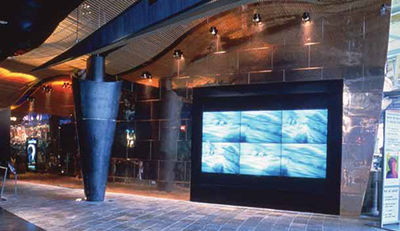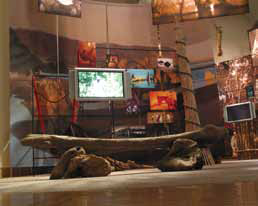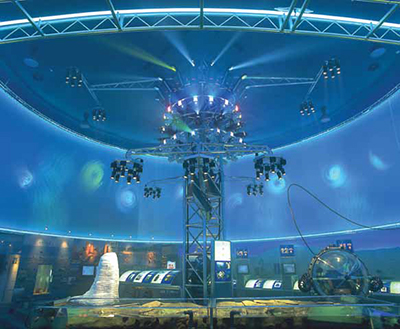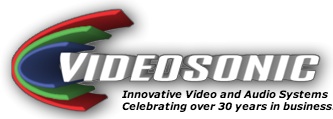Quick Bio

Company: VideoSonic Systems
Headquarters: New York, NY
Overtime: VideoSonic founder and CEO Glenn Polly was mentioned in a 1984 New York Post front page news brief about a “video-dance club” that was robbed of its AV equipment. “Polly came to the rescue and installed new equipment in less than 24 hours,” the Post stated.
One night in the early ’80s, a young keyboardist wrapped up a gig with his cover band, and instead of packing up the PA system he owned, he learned the NY C club was planning to rent one that weekend and cleverly convinced the club owner to buy his instead.
“Disco was booming, and before long, I was installing live sound and DJ systems in nightclubs all over the Tri-State area,” said Glenn Polly, founder and CEO of VideoSonic Systems.

VideoSonic created a showcase entertainment complex in the “back yard” of United Artists Starport Theaters’ corporate headquarters in Denver, CO. Located at the Park Meadows Mall, the multi-screen theater complex also featured a motion ride simulator roller coaster, a virtual reality hang glider ride where a person straps into a harness suspended over a video screen and can fly over a virtual landscape, and other video games. “I was installing projectors and screens and setting up VJs with VHS Hi-Fi VCRs and mixers, so people could dance to music video. Chances are, if you were at a NY C nightclub in the ’80s and saw a Rock America or Telegenics music video, you were watching it on a VideoSonic system.”
Through this work, VideoSonic helped introduce major manufacturers, like Sony and Panasonic, to nonbroadcast pro video end users, opening up a new market for video equipment. In these early days of business, Polly also worked with an engineering friend of his to develop a means for mixing video with records without altering the picture. Polly had actually bet the friend he couldn’t do it, but after working on it for just a week or so, the engineer created a modification enabling the tracking control to vary the pitch of audio. This allowed video to mix with audio from records as the BPM (beats per minute) on the video could be adjusted +/- 8 percent.
After showing the technology to representatives at Panasonic, Polly said, the company approved the pitch control modifications, so it didn’t void any warranty, which was a big deal for him and his clients.
Now in its 32nd year of business, VideoSonic serves various markets, specializing most prominently in museum exhibits, but also finance, legal, higher education, healthcare, houses of worship, and retail/digital signage.
VideoSonic’s big break into the museum installation sector came in 1990 when the Ellis Island Immigration Museum opened. Polly has been working for the National Parks Service ever since.

National Museum of the American Indian “Edge of the Enchantment” is part of the permanent exhibit collection and this branch of the Smithsonian in NYC. VideoSonic produced an AV environment using curved rear-projection screens and flat-panel displays, so they appear to float in front of artifacts depicting life in this Mexican village. All AV sources are Alcorn McBride DVM, and all signals are transported over Cat-5e cable from the control room located in the basement of the building.

The Expo 1998 celebrated “ The Year of the Ocean” at the last world’s fair of the century in Lisbon, Portugal. VideoSonic provided an interactive multimedia display system that demonstrated undersea exploration and technology used by the U.S. Navy and private organizations, such as Woods Hole and Scripps Institute. The display system incorporated the latest in digital MPEG video player technology and the entire pavilion was automated by show control. Around that same time, Polly went to Brisbane, Australia to work on the world’s fair, which he also worked on for subsequent fairs in Seville, Spain and Taejon, Korea. He worked his way up the ranks of the U.S. Information Agency to serve as technical director for the U.S. Pavilion at Expo 1998 in Lisbon, Portugal, an accomplishment he is very proud of.
“Working on World’s Fair projects are really a trip, and [they] enabled me to really develop my skills,” Polly said. “The jobs entail meeting with corporate clients and other participants and designing an exhibit to display their technology or brand. VideoSonic was quite busy in the museum, exhibition, and retail industries because of our skill set with projection, lighting, special effects, and show control automation.”
To fill in between big museum jobs, VideoSonic worked on corporate boardrooms, meeting rooms, and classrooms. Today, “VideoSonic is still known for our museum work, but now, we are also gaining a very good reputation for our corporate and classroom projects, which have become a major percentage of VideoSonic revenue.”
Polly has great pride in the team he employs, which includes 18 full-timers, four of whom are certified engineers. VideoSonic is a Diamond Certified Audiovisual Solutions Provider with half the staff trained and certified by InfoComm with a minimum CTS, with at least one CTS-D and one CTS-I.
The most valuable asset for VideoSonic is its customers and their referrals. “Almost 100 percent of our new clients and projects come via recommendations from previous successful projects,” Polly said. “I often tell a new client at the beginning of a project that I’ll expect a similar letter of recommendation when their project is finished.”
But the ultimate satisfaction for a job well done, Polly said, is “After a roll call is read naming the sailors that perished at the end of the Kamikaze Attack show aboard the Intrepid [Air and Space Museum], and there’s not a dry eye in the room. That’s how you know you did your job right.”
Lindsey Adler is associate editor for SCN, Residential Systems, and Healthcare AV.

